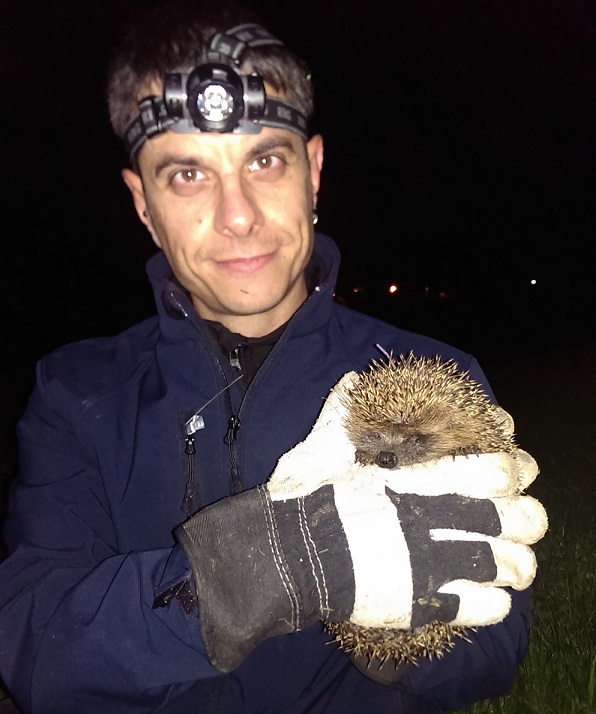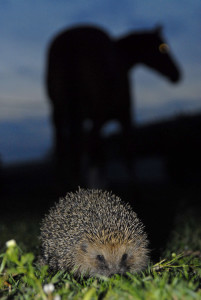Rural and urban hedgehogs

Status
Native and locally common but declining across the UK
Population
Current estimates suggest less than 1 million remain
Scientific name
Erinaceus europaeus
This project has now finished
Research has shown that populations of hedgehogs have declined dramatically in the last 50 years. New methods need to be developed to monitor hedgehog densities across a range of habitat types.
The problem
The hedgehog is currently of conservation concern within the UK as populations appear to have declined markedly since the 1950s. Current methods used to monitor hedgehog populations are associated with factors which either limit their use for long-term monitoring and not all can be applied easily in all habitats, or are unable to yield population density estimates.
The solution
A collaborative project led by Nottingham Trent University, in conjunction with Hartpury College, and the Universities of Reading and Brighton will take place during 2016 to estimate hedgehog densities at different sites across England with the aim of validating the suitability of the Random Encounter Model (REM). The REM method uses camera traps and combines information on camera detection rates, survey effort and area covered with data on animal movements to generate animal densities.
This method could potentially provide a standardised method to obtain hedgehog density estimates across a range of habitat types, which in turn would inform planners, developers, local governments and conservation organisations.
Latest update
Hedgehog Research – why do we do it and what are the rules?
It is now well known that the population of hedgehogs in Britain is suffering from a serious decline. The most recent analysis of the research done through the combined work of the British Hedgehog Preservation Society and the People’s Trust for Endangered Species indicates that urban populations have fallen by up to 30% and rural populations by at least 50% since the turn of the century.
At the heart of our response to this knowledge has to be rigorous science. The only way we will be able to convince those responsible for changes to conservation policy on a national level will be to present a case that is backed up with robust evidence.
Collection of this evidence requires further research. And the main supporters and instigators of research to benefit hedgehogs in Britain are the BHPS and the PTES.
All research projects have to meet a series of demanding tests before they are allowed to be undertaken. There are legal requirements, along with ethical and practical considerations.
Legal
Hedgehogs are protected, in England, Scotland and Wales, under the Wildlife and Countryside Act 1981, Schedule 6 and in Northern Ireland under the Wildlife (NI) Order 1985, Schedules 6&7. What this means is they are
“protected from being killed or taken by certain methods under Section 11(1) of the Wildlife and Countryside Act 1981. The methods listed are: self-locking snares, bows, crossbows, explosives (other than ammunition for a firearm), or live decoys. The species listed are also protected from the following activities: trap, snare or net, electrical device for killing or stunning, poisonous, poisoned or stupefying substances or any other gas or smoke, automatic or semi-automatic weapon, device for illuminating a target or sighting device for night shooting, artificial light, mirror or other dazzling device, sound recording, and mechanically propelled vehicle in immediate pursuit.”
Licencing
Licences to undertake research come from Natural England, Natural Resources Wales, Scottish Natural Heritage and the Northern Ireland Environment Agency.
A survey licence is required for work on hedgehogs if the animals are to be trapped or taken with the use of artificial light, such a torch or spotlight.
A survey licence is not required: for surveys of hedgehog field signs, for direct observation or for presence/absence surveys where they are observed or detected without ‘taking’ (such as trapping or handling) e.g. for the use of footprint tunnels, remote camera traps, or for habitat appraisal or general ecological survey purposes.
In addition to this, anyone applying sedatives to animals for research purposes must be a vet or licensed under the Animals (Scientific Procedures) Act 1986.
The Chartered Institute of Ecology and Environmental Management has also put together a series of criteria they consider to be a minimum for research to be undertaken:
Knowledge
Individuals should have a knowledge and understanding of:
- conservation status
- distribution
- threats to populations, species range (including introduced populations) and species survival
- hedgehog ecology, breeding biology and behavior
- known ecological requirements
- legal protection
- licensing and permissions
- appropriate survey seasons
- survey methods used to survey for hedgehogs (including trapping, marking/tagging, field searching and using footprint tunnels and camera traps) and the strengths, weaknesses and limitations of these methods
- appropriate equipment, methods and licensing requirements for humane live-capture, handling and sedation of hedgehogs (if intending to use these techniques) and the legal issues surrounding potential by-catch
- range of factors that might lead to bias in the survey results, and false negatives
- sources of information on known occurrence and distribution of hedgehogs (including NBN Gateway, local biological/environmental records and local contacts)
- metadata standards / data sharing
- health and safety and welfare issues commonly associated with surveying for hedgehogs (including live- trapping and handling of wild animals if relevant).
Skills
Individuals should have skills and experience enabling them to confidently:
- identify field signs for hedgehogs
- assess habitat potential for hedgehogs
- scope fieldwork appropriately
- plan and implement sound scientific surveys (appreciating the effect of season and habitat on survey methods)
- use relevant non-invasive survey methods for hedgehogs
- analyse and interpret survey data
- take appropriate health and safety precautions.
If trapping is used, individuals should also be able to:
- deploy and monitor live traps effectively
- legally and humanely handle live hedgehogs
- effectively record biometric data from live hedgehogs
- legally and humanely mark/tag hedgehogs (if using this technique)
- correctly handle a range of potential by-catch from live-traps (with due regard to relevant legislation).
Much of this material was put together by Dr Richard Yarnell and Dr Nigel Reeve on behalf of the CIEEM
In summary, the work that is commissioned by the BHPS and the PTES is required to meet the legal, practical and ethical demands above. Where there is evidence of the highest standards not being met, we would take immediate action to uncover what has gone wrong.
Sometimes appearances can be deceiving. The heat shrink plastic tags that are now the standard marking technique do not require plastic to be melted onto the spines and cause the hedgehog no trouble at all. It is not far off humans getting hair-extensions.
Hedgehogs are only tagged and released if in good health. There are times when a hedgehog will become poorly after release – and this can be distressing for all concerned.
If you find a hedgehog that is in a bad way and clearly marked and involved with research, please do contact the BHPS, after making sure the animal is safe and secure in a cardboard box (or similar) so that we can advise on the nearest rescue and also alert the researchers.
Without the work undertaken by researchers we will not be in a position to argue for better protection for hedgehogs. Research is crucial to furthering our understanding of the threats hedgehogs face and to formulating responses.

